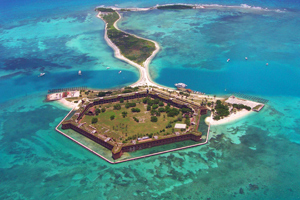| Error processing SSI file |
||
| Error processing SSI file |
||
| Error processing SSI file |
||
Error processing SSI file |
About Marine Protected Areas
Dry Tortugas National Park
Dry Tortugas National Park The Dry Tortugas – about 70 miles west of Key West -- were discovered by Ponce de Leon in 1513. The route was frequently used by Spanish ships returning home from Mexico, the Caribbean or the Gulf Coast of Florida. Dry Tortugas proved to be an important passageway and served as an excellent navigational marker. The United States purchased Florida in 1822 and immediately began planning for the creation of a large fort in Dry Tortugas. They believed the 75 mile wide straits between the Gulf Coast and Atlantic Ocean were crucial to protect, because anyone who tried to occupy the area were sure to gain control over Gulf Coast trading routes as well. The result of this was Fort Jefferson, which began construction in 1847 on Garden Key Island. By 1860, the United States had spent over $250,000 and the fort was only halfway completed. Work on the fort continued through the Civil War, but was ended as soon as the war ended. The fort is one of the largest 19th century American masonry forts, even incomplete. During the Civil War, Fort Jefferson was used as a military prison. One of its most famous inmates was Dr. Samuel Mudd, who set the leg of John Wilkes Booth following the assassination of President Lincoln. Mudd was convicted of aiding and conspiring in the assassination. Mudd was incarcerated in Dry Tortugas from 1865-1869, but was then pardoned by President Andrew Johnson. His conviction, however, has never been overturned. Did you know?
Learn more/get involved:
|
|
